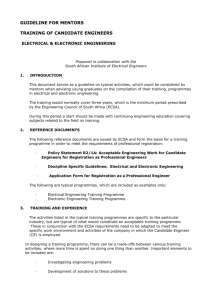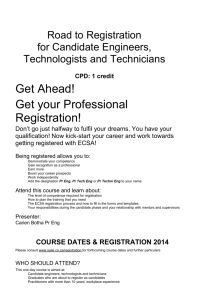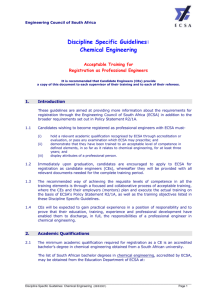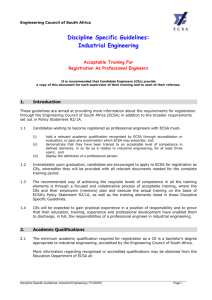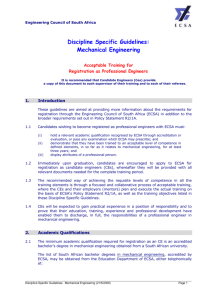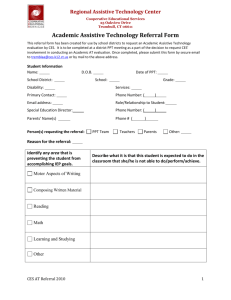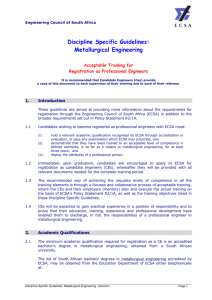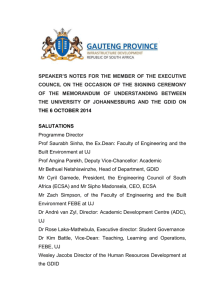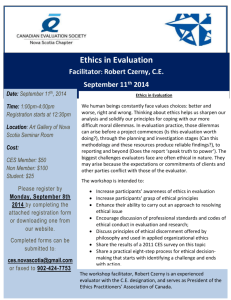Mining Engineering
advertisement
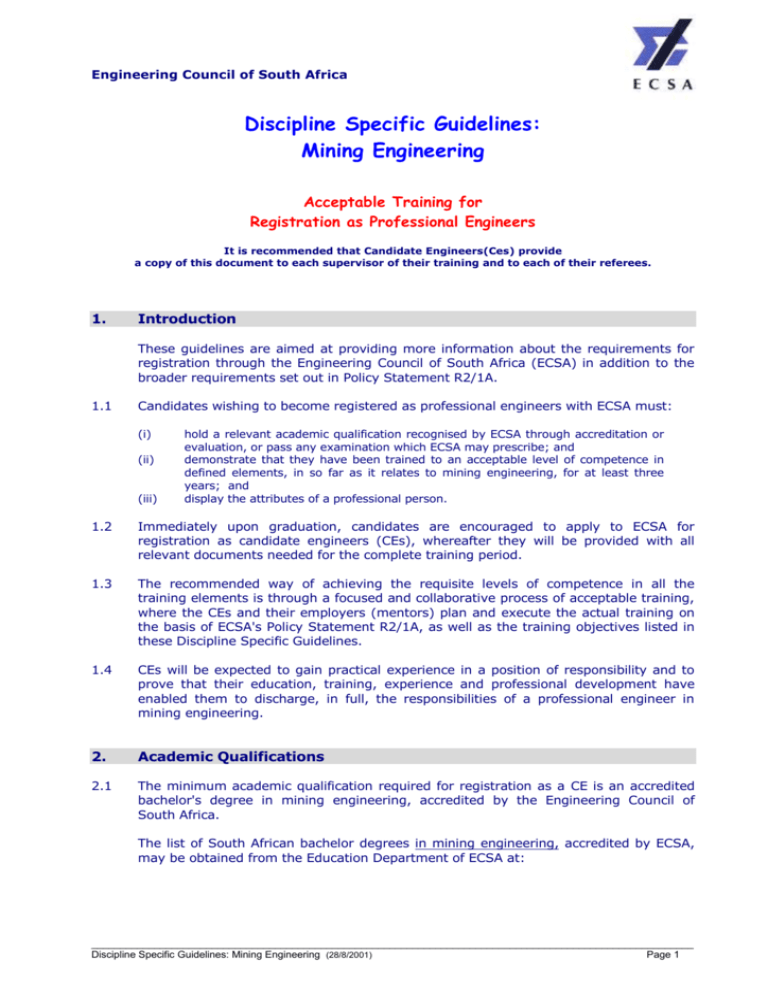
Engineering Council of South Africa Discipline Specific Guidelines: Mining Engineering Acceptable Training for Registration as Professional Engineers It is recommended that Candidate Engineers(Ces) provide a copy of this document to each supervisor of their training and to each of their referees. 1. Introduction These guidelines are aimed at providing more information about the requirements for registration through the Engineering Council of South Africa (ECSA) in addition to the broader requirements set out in Policy Statement R2/1A. 1.1 Candidates wishing to become registered as professional engineers with ECSA must: (i) (ii) (iii) hold a relevant academic qualification recognised by ECSA through accreditation or evaluation, or pass any examination which ECSA may prescribe; and demonstrate that they have been trained to an acceptable level of competence in defined elements, in so far as it relates to mining engineering, for at least three years; and display the attributes of a professional person. 1.2 Immediately upon graduation, candidates are encouraged to apply to ECSA for registration as candidate engineers (CEs), whereafter they will be provided with all relevant documents needed for the complete training period. 1.3 The recommended way of achieving the requisite levels of competence in all the training elements is through a focused and collaborative process of acceptable training, where the CEs and their employers (mentors) plan and execute the actual training on the basis of ECSA's Policy Statement R2/1A, as well as the training objectives listed in these Discipline Specific Guidelines. 1.4 CEs will be expected to gain practical experience in a position of responsibility and to prove that their education, training, experience and professional development have enabled them to discharge, in full, the responsibilities of a professional engineer in mining engineering. 2. Academic Qualifications 2.1 The minimum academic qualification required for registration as a CE is an accredited bachelor's degree in mining engineering, accredited by the Engineering Council of South Africa. The list of South African bachelor degrees in mining engineering, accredited by ECSA, may be obtained from the Education Department of ECSA at: _________________________________________________________________________________________________________ Discipline Specific Guidelines: Mining Engineering (28/8/2001) Page 1 Tel: Fax: E-mail: Web: (011) 607-9500 (011) 622-9295 engineer@ecsa.co.za www.ecsa.co.za or in writing at: Private Bag X691 Bruma 2026 2.2 Persons who have graduated from a university not accredited by ECSA will be assessed individually on merit. If their qualifications are evaluated as being at least equivalent to an accredited South African degree, candidates will be eligible for registration as CEs and could then follow the formal route to registration as professional engineers. 2.3 Persons whose qualifications are not accredited or recognised by ECSA may follow an alternative route to meet the academic requirements for registration as CEs. Candidates must apply to ECSA and obtain the necessary information on the procedure to be followed. 2.4 Those who meet ECSA's academic requirements should register as CEs without delay. Application forms can be obtained from ECSA. CEs must, from the outset, also obtain copies of the application form for registration as professional engineers. 3. Training and Professional Development under a Commitment and Undertaking (CU), and Mentorship Commitment and Undertaking (CU) 3.1 CEs must persuade their employers to register a Commitment and Undertaking with ECSA, namely that they will structure the training of, and actually train, their CEs, in accordance with the requirements of ECSA's Policy Statement R2/1A as well as the requirements set out in these Discipline Specific Guidelines. Each CU will be allocated a permanent registration number, which should be quoted by all CEs when applying for registration as professional engineers. 3.2 Employers must, at the same time, submit the name(s) of a mentor(s) from within the organisation (see § 3.4 below) or, if an internal mentor is not available, the name of an external mentor (see § 3.5 below) to guide CEs through the required process of training. A CU will not be registered by ECSA unless the name of at least one mentor (internal or external) is provided. Mentorship and Supervision 3.3 ECSA and the Institute of Mining and Metallurgy (SAIMM) will jointly maintain a list of internal and external mentors. A mentor must be registered as a professional engineer. Council will only in exceptional cases consider the listing of experienced and mature professional engineering technologists, professional certificated engineers, or professional engineering technicians, upon application and motivation by the organisation/mentor concerned. These mentors will be deemed not only to be capable of fulfilling their functions in a professional manner but also as being committed to advising and guiding their CEs in their professional development. 3.4 It is STRONGLY RECOMMENDED that all CEs should have a mentor who is working in the same organisation as the CE. 3.5 If a mentor is not available internally in the organisation, a list of external mentors can be obtained from ECSA or SAIMM. It will be expected of employers who make use of the services of external mentors to create an environment in which such mentors can feel free to make recommendations in the reasonable knowledge that their recommendations will be given sympathetic consideration. _________________________________________________________________________________________________________ Discipline Specific Guidelines: Mining Engineering (28/8/2001) Page 2 3.6 It will be expected of all mentors to become fully conversant with their functions and responsibilities referred to in Policy Statement R2/1A and guidelines issued by ECSA from time to time, to conduct regular discussions with their CEs and to assess their progress in accordance with the guidelines set out in Policy Statement R2/1A and these Discipline Specific Guidelines. Since the effectiveness of mentors will be monitored continuously, Council will attach much value to the opinion of "the conscientious mentor" as to the registrability (or otherwise) of their CEs. 3.7 It is not expected of mentors to take responsibility for the day-to-day supervision and training of CEs. Mentors/employers should, however, do everything in their power to ensure that competent persons, preferably registered with ECSA, are available to oversee this function. 4. GENERAL 4.1 Training reports, which must be updated regularly, form an essential part of the monitoring process, and these reports must be filled in on the correct forms (Forms A2.1 and A2.2) of the application form. These forms should be obtained from ECSA as soon as the CEs start their training. 4.2 It is a requirement that CEs who are aspiring to become professional engineers should, with the assistance of their mentors, achieve their training objectives by structuring their training in such a way as to cover the various elements of training referred to in Policy Statement R2/1A and these Discipline Specific Guidelines. 4.3 The rate at which CEs progress through their training is determined by themselves, their mentors and other factors, such as the state of the economy and availability of training opportunities. 4.4 Where CEs, training under a CU decide to change employers, they should ensure that they continue their training under another CU registered with ECSA by their new employers. CEs should also ensure that their new employers provide mentors to guide them through the remainder of their training period and to take over where the previous mentor ended. It may even be advisable to retain the previous mentor, if this is at all practicable. 4.5 Once all the objectives have been achieved to the satisfaction of the mentor, CEs should, in principle be registerable, and could then apply for registration as professional engineers. Depending on the circumstances, CEs may expect to take a minimum of three years to achieve acceptable competence in all the prescribed elements. 4.6 Regardless of whether or not CEs train under a CU, it is recommended that they strive to participate in a process of continuing learning. This concept includes continuing education and professional development. 4.7 Continuing learning may include the attending of courses, technical conferences, seminars, symposia, organised site visits, as well as meetings of professional bodies and self-study. The programme of continuing learning should achieve a balance between technical content and managerial/professional aspects. 4.8 The mentors of CEs should, on a consultative basis, suggest suitable continuing learning programmes. 4.9 SAIMM and educational institutions may be able to assist in advising on courses which are available. _________________________________________________________________________________________________________ Discipline Specific Guidelines: Mining Engineering (28/8/2001) Page 3 4.10 It will be to the advantage of CEs when applying for registration as professional engineers if they can demonstrate their participation in a process of continuing learning. 5. Professional Attributes The following attributes are considered common to all professional engineers and the requirements for these attributes are designed to ensure that CEs acquire competence with respect to professional responsibility in decision making, engineering judgement, leadership, communication and an appreciation of their own professional and working environments. 5.1 Professional Responsibility CEs must ensure that their work reaches a level of responsibility commensurate with that which ECSA would normally expect of an engineer with three years post-graduate experience, both in terms of the type and level of work being performed. This means that responsibility for directing personnel, money and materials must be taken during the execution of a project, or part of a project. When applying for registration as a professional engineer, CEs must demonstrate their ability to work satisfactorily on their own, that they have taken responsibility and, in having done so, achieved a satisfactory outcome. To satisfy this requirement applicants should have completed one or two projects where their engineering ability will have been tested. A project report or reports must be submitted on Form AF7 with the CE's application. It should clarify the depth of their role in the project and provide the background to important decisions for which, they were responsible. It must also indicate any financial or economic considerations the project has had on operations. The report should be brief and incorporate drawings, numerical analysis and cost data. 5.2 Engineering judgement displayed in practical application When applying for registration as professional engineers, CEs must demonstrate that their engineering work required them to – 5.3 exercise independent technical judgement, combining their experience and application of engineering principles; accept responsibility for such decisions; and understand and take into account financial, economic, commercial and statutory considerations. Communication Skills CEs must develop the ability to communicate lucidly, accurately and with confidence. ECSA will base its assessment of CEs communication skills on the quality of the application presented. 5.4 Professional Environment To a large extent this will be covered, provided applicants have obtained a Certificate of Competency in the field of Mining Engineering i.e. Mine Managers, Survey, Rock Mechanics, Environmental Control, etc. CEs must, when reporting to their mentors on a regular basis, and in discussions with them, demonstrate that they have: _________________________________________________________________________________________________________ Discipline Specific Guidelines: Mining Engineering (28/8/2001) Page 4 6. a general understanding of engineering procedures applicable to their discipline of engineering; a general knowledge of legislation which has a bearing on the practice of engineering in South Africa, with a detailed knowledge of the important sections of the Engineering Profession Act, 2000 (Act 46 of 2000) and the Acts and Regulations applicable to their specific discipline of engineering; an understanding of the Code of Professional Conduct applicable to registered persons; an understanding of the purpose of and relationship between the various organisations involved in their discipline of engineering; and full familiarity with the requirements for registration set out in Policy Statement R2/1A as well as these Discipline Specific Guidelines. Discipline Specific Elements Each heading should have been covered but not necessarily all the supplementary elements mentioned after each heading. It should be demonstrated that the CE has become a well-rounded Engineer. MINING ENGINEERS Those engineers whose training has been concerned with the production process should demonstrate that they have obtained experience in:1. 2. 3. 4. 5. Production - General Mining Processes including Health and Safety. Planning & Design - To be covered in project report. Project Work / Research - See Form AF7 attached to this document. Technical Services - Study Survey and Ore Evaluation, Ventilation, Rock Mechanics, Benefication, Geology, Grade Control and Administration. Supervisory Experience - Shift boss, Mine Overseer or equivalent. ROCK ENGINEERS Those Engineers whose training has been concerned with Rock Mechanics should demonstrate that they have obtained experience in:1. 2. 3. 4. Basic Mining - General Mining Processes including Health and Safety, Support Installation and Rock Stability. Project Work in Rock Mechanics - See Form AF7 attached to this document. Design in Rock Mechanics - Optimisation of mining layouts, Computer applications in Rock Mechanics. Supervision of Rock Mechanics - Support installation in a supervisory capacity, e.g. Shift Boss / Mine Captain equivalent maintenance and monitoring of support installations. ENVIRONMENTAL Those Engineers whose training has been concerned with the ventilation of mines should demonstrate that they have obtained experience in: 1. 2. 3. 4. 5. Basic Mining - General Mining Processes including Safety and Health. Project Work - See Form AF7 attached to this document. Mine Environment Design & Specification - Layouts, Cooling, Fan specifications. Supervision of Ventilation - Controlling and monitoring dust, air control, fumes and gasses in a section of a mine, installation of fans, air conditioners, etc. Installation - Of Fans, Air Controls, Brattices, etc. _________________________________________________________________________________________________________ Discipline Specific Guidelines: Mining Engineering (28/8/2001) Page 5 MINERAL EVALUATIONS Those Engineers whose training has been concerned with the evaluation of ore deposits should demonstrate that they have obtained experience in: 1. 2. 3. 4. 5. 6. Basic Mining - General Mining Processes including Safety and Health. Tonnage / Grade Estimates - Sampling, Regression, Geostatistics, Kriging, Geology, Sedimentology on Evaluation process. Planning - Impact of Mine layouts on the Evaluation Process, Rock Mechanics. Survey - Appreciation of survey techniques and interpretation of mine plans. Project Work - See Form AF7 attached to this document. Economic Evaluation - Costs, Revenue, Pay Limits, Life of Mine calculations, Cash Flow Estimates, Rate of Returns, etc. _________________________________________________________________________________________________________ Discipline Specific Guidelines: Mining Engineering (28/8/2001) Page 6 Engineering Council of South Africa (970731) Form AF7 Project Executive Summary Report: Mining Engineering Use this form to report on a project to which you have made a significant contribution. Use a new form for each project. At least one, but not more than three projects. Name: __________________________________ Application Ref. No:_____________ Project name and date(s) Engineering brief and Objective Environment (Industry; Laboratory; Theory; Simulation) Summary (State engineering problems; solutions) Your contribution to the project (State aspects of engineering judgment) Title of report or publication Budget Signature of Applicant: ____________________________________ Date: ____________________________ Signature of Supervisor: ___________________________ _________________________________________________________________________________________________________ Discipline Specific Guidelines: Mining Engineering (28/8/2001) Page 7
